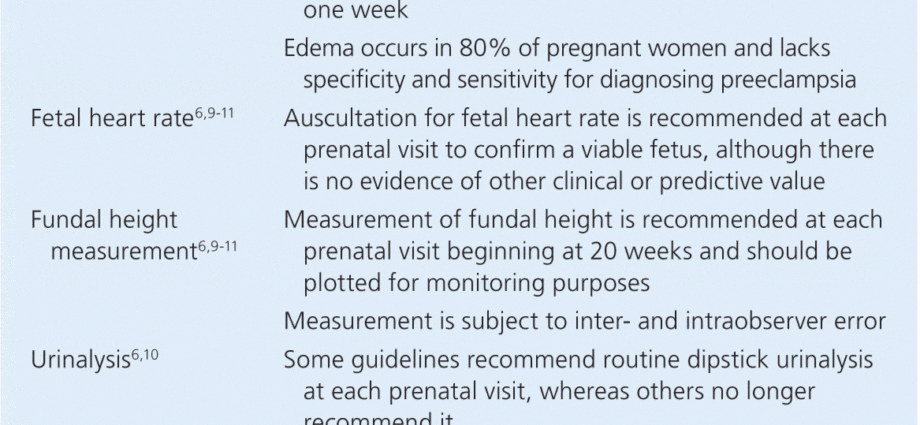Contents
Update on prenatal visits in the second and third trimester
After the first trimester prenatal visit which marks the start of pregnancy follow-up, the pregnant woman benefits from a follow-up visit each month. The objective of these monthly consultations: to monitor the growth of the baby, detect possible complications of pregnancy as early as possible and ensure the well-being of the mother-to-be.
Take stock of ultrasound scans
In France, pregnancy monitoring includes 3 ultrasounds, not compulsory but systematically offered to expectant mothers and highly recommended:
- a first so-called dating ultrasound to be performed between 11 and 13 WA + 6 days;
- a second so-called morphological ultrasound at 22 weeks;
- a third ultrasound at 32 weeks.
During the prenatal consultation, the gynecologist or midwife studies the ultrasound report and may have to prescribe additional examinations or adapt the pregnancy follow-up.
After the first ultrasound:
- if the measurement of nuchal translucency on ultrasound combined with the dosage of serum markers and maternal age lead to a risk of trisomy 21 greater than 1/250, a trophoblast biopsy or amniocentesis will be offered to the mother in order to ‘establish a karyotype;
- If the biometric dating (measurement of certain parts of the fetus) shows a gestational age different from that calculated according to the last period, the practitioner will modify the APD (expected date of delivery) and adjust the pregnancy calendar accordingly.
After the second ultrasound:
- if a fetal anomaly is detected or if a doubt persists, the practitioner can prescribe a follow-up ultrasound or refer the mother-to-be to a prenatal diagnosis center;
- if the ultrasound shows a modified cervix (confirmed by an endovaginal ultrasound), the practitioner can take certain measures to prevent a threat of premature delivery: sick leave, rest, or even hospitalization in the event of contractions;
- If the fetal growth is not satisfactory, a follow-up ultrasound will be ordered to monitor the baby’s growth.
After the third ultrasound:
- depending on the different elements of the ultrasound (biometry and presentation of the baby, estimation of the fetal weight, position of the placenta) and the clinical examination of the mother (internal pelvimetry by vaginal examination to assess the morphology of the pelvis in particular), the gynecologist or midwife makes a prognosis on the course of childbirth. If vaginal delivery seems difficult, risky or even impossible (in the case of placenta previa covering in particular), a cesarean section may be scheduled;
- if a foeto-pelvic disproportion (risk that the baby cannot pass through the pelvis) is suspected, pelvimetry will be prescribed to check the dimensions of the maternal pelvis;
- in case of presentation at headquarters, an external maneuver version (VME) may be considered;
- if the fetal growth, the quality of the fetal-maternal exchanges or the quantity of amniotic fluid are not satisfactory, a follow-up ultrasound will be performed.
Follow the growth of the fetus
In addition to the three ultrasounds which, thanks to biometrics, allow the growth of the fetus to be monitored, the gynecologist or midwife has a very simple tool to follow this growth during monthly prenatal consultations: the measurement of the uterine height. This gesture consists in measuring, using a seamstress tape measure, the distance between the upper edge of the pubic symphysis (the pubic bone) and the uterine fund (the highest part of the uterus). As the uterus grows in proportion to the baby, this measurement gives a good indication of the growth of the baby as well as the amount of amniotic fluid. The practitioner performs this gesture at each prenatal consultation from the 4th of pregnancy.
Talk about your daily life, how you experience pregnancy
During prenatal consultations, the gynecologist or midwife checks, with a few questions, of your well-being – physical but also psychic. Also do not hesitate to share your various pregnancy ailments (nausea, vomiting, acid reflux, back pain, sleep disorders, hemorrhoids, etc.) but also any worries and anxieties.
Depending on this questioning, the practitioner will give you various hygienic and dietary advice to prevent pregnancy ailments and, if necessary, will prescribe a treatment adapted to the pregnancy.
In the event of mental distress, he can direct you to a consultation with a psychologist, at your place of birth for example.
He will also be attentive to your lifestyle – diet, smoking, working and transport conditions, etc. – and will provide prevention advice accordingly, and if necessary will set up specific care.
Check your health
During the clinical examination, systematic at each prenatal consultation, the practitioner checks various elements to ensure your good health:
- taking blood pressure, to detect hypertension;
- the weighing ;
- a palpation of the abdomen and possibly a vaginal examination.
He is also attentive to your general condition and inquires about any abnormal signs: urinary disorders which may suggest a urinary tract infection, abnormal vaginal discharge which may be a sign of a vaginal infection, fever, bleeding, etc.
Of course, in the presence of such warning signs, you should consult without delay apart from the monthly follow-up.
Screen for certain pregnancy diseases
This clinical examination, associated with the various biological examinations prescribed during pregnancy and ultrasound scans, also aims to detect certain fetal and obstetric complications as early as possible:
- gestational diabetes;
- hypertension or pre-eclampsia;
- a cake in advance;
- uterine growth retardation (IUGR);
- a threatened preterm birth (PAD);
- cholestasis of pregnancy;
- Rhesus incompatibility;
- .










